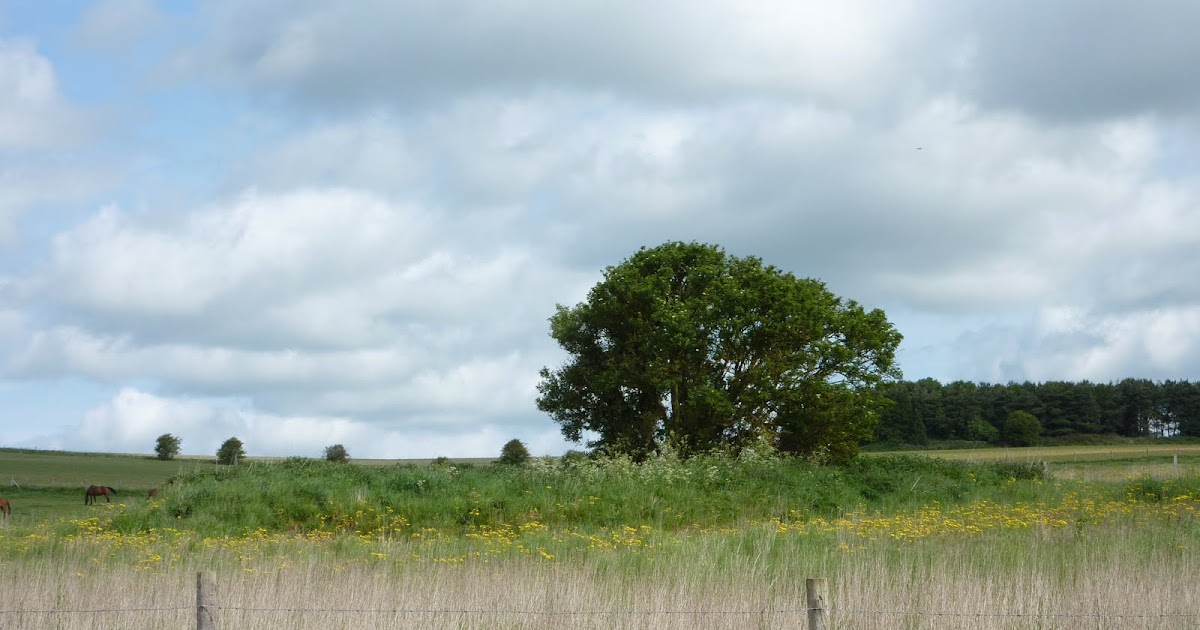
Ancient East England burial mounds
Once called ‘The Fairy Hills’, the ‘Pyramids’ of the Essex/Cambridge borders (in the East of England) are in fact Roman burial mounds of the second century AD, presumably of local British aristocrats, buried in what appears to be a syncretic combination of Celtic and Roman-Etruscan funeral monuments. The grave goods (apparently since lost) included expensive glass, decorated bronze, and enamel.
The mounds are striking, and after dark, very eerie, the silence broken only by the occasional hooting of an owl and rustling of foxes and badgers in the undergrowth. Folklore pertaining to the area includesthis recollection:
“An eighty year old woman of Linton in the 1930s said that in her youth the villagers of Linton and Hadstock used to skip on Good Friday to Bartlow Hills to join in the fun of the fairs held there.”
The Lord Protector Oliver Cromwell was said by local legend to have buried treasure “in the barrows known as the Three Hills, or in pits near them.” For what earthly reason?
'The Beauties of England and Wales, Or, Delineations, Topographical, Historical, and Descriptive' by John Britton and others (1801) declares, ‘In the parish of ASHDON, separated from Bartlow, in Cambridgeshire, only by a small rivulet, are four large contiguous Barrows, called the BARTLOW HILLS, from their situation being not very distant from Bartlow Chuch. These are vulgarly regarded as the tumuli raised over the slain in the battle fought between Edmund Ironside, and the Danish King, Canute, in the year 1016; but as this tradition is not supported by any historical authority, it cannot be considered as deserving of credit.’
Earlier, Camden reports in his 'Britannia' of 1610 that:
"Dane-wort which with bloud-red berries, commeth up heere plenteously, they still call by no other name than Danes-bloud, of the number of Danes that there were slaine, verily beleeving that it blometh from their bloud."
Similar to to poppies growing on the WW1 battlefields. Danewort is believed to be dwarf elder (Sambucus ebulus).
Witchy England - Bartlow village
There is also the rather prosaic tale of a local crone in nearby Bartlow village:
‘There was always a 'village witch' in Bartlow, with each one passing on her magical paraphernalia (broomstick, black pussycat, cauldron?) to the next. Before the First World War, the incumbent witch was buried at the crossroads, with the 'bump' of her grave still being visible in grass years later. This would probably be at the junction of Dean Road and Camps Road, where the village sign now stands.
The tale is told of a farmer who wanted to move house, possibly because the then-current witch had put a hex on him, and he needed to get away - but when the moving van carrying his furniture reached the grave at the crossroads, the vehicle broke down.’

Source: Enid Porter: ‘Cambridgeshire Customs & Folklore’, (Routledge & Kegan Paul, 1969)
Resist being drawn into a fairy mound
My favourite supernatural story associated with the Bartlow Hills in England is that, like Silbury, ‘Fairies, Elementals and Nature Spirits’ were believed to inhabit these ancient manmade mounds. In the dead of night, sounds of revels can be heard coming from within them. Twinkling, sparkling, lights have seen on the summits of the three hills. But unlike Old Rip Van Winkle, you must resist being drawn into a fairy mound. Although you will be warmly welcomed and invited to eat, drink and be merry by these seemingly friendly beings, as you party, their wicked enchantment will have dealt you a nasty blow, one hundred years will have elapsed and all those you loved will be long dead.

A supposedly paranormal exploration of the site:

Silbury Hill legends and supernatural stories
Silbury Hill, England is the largest prehistoric man made mound in Europe and, as one would expect, has many legends and supernatural stories associated with it.
1. The burial site for King 'Sil'. A solid gold statue of the dead king sat astride a golden horse was thought to be buried with him. His ghost is said to ride around the foot of Silbury when there is a full moon.
2. An ancient fertility symbol (of a pregnant tummy?) dedicated to the earth goddess. Swallowhead Spring, which rises 450m (492yrds) south of the hill and source of the River Kennet, is still thought to have health and fertility properties, yay, even unto 2024.
4. The Devil, who, on his way (for some reason best known to His Excellency) to bury the town of Marlborough under a huge sack of earth, encountered the priests of Avebury. After a heated debate, in a fit of pique, The Horned One dumped his sack on the spot, thereby creating Silbury Hill.
4. A massive solar observatory or giant sun dial used to measure the seasons of the year. Silbury casts a shadow across the level plain north to Avebury.

Marlborough Mound - the burial place of the wizard Merlin?
Dating from around 2400 BC, the Marlborough Mound at Marlborough College in England is the second tallest prehistoric monument in Europe after Silbury Hill. Long thought to be the remains of a Norman motte, it was only in 2011 that scientists discovered the hillock was 4,400 years old. The Mound is said to be the burial place of the wizard Merlin, and the town of Marlborough's motto is 'Ubi nunc sapientis ossa Merlini' ('Where now lie the bones of wise Merlin'). No evidence of the wizard’s mortal remains and effects (pointy hat, wand, starry cape, crystal ball, etc) have yet been discovered.
The name Marlborough itself is supposed to be a corruption of 'Maerle beorg' - ‘Maerla's barrow’ - ‘Merleberge' - then Marlborough.
On a more prosaic note, in John Aubrey’s Monumenta Britannica there’s a passage concerning the ‘marl’ element in the place-name that was told to him by a local man called Edward Leigh, which said, “Marga, marle, we use instead of dung to manure our ground. It (Marlborough) lieth near a chalky hill, which our ancestors knew. They borrowed this name ‘chaulk’ of the Latin, calx, named marle.”

The Marlborough Mound in more detail:
Rome’s ‘Broken Pot Mountain’:

Another Roman mound, but with a very different purpose from Bartlow, Mount Testaccio (‘Broken Pot Mountain’) in Rome:
During my recent trip to Rome I also saw the restoration work on the Etruscan Tumuli-inspired Mausoleum of Augustus:

And what the present-day Castel Sant’Angelo (also in Rome) may have looked like when originally built as the Mausoleum of the emperor Hadrian:

Back to England, with the dread Haunted Manton Barrow near Marlborough:

Haunted Wiltshire - many believed that barrows were the threshold to the underworld
Altogether more scary than the Marlborough Mound in England, is Manton Long Barrow, which has a tale that rivals the ghost stories of M.R. James; this from HAUNTED WILTSHIRE:
It was during the 1906 excavation that several of the village folk warned of disturbing the grave and that no good would come of such a desecration by so-called 'hill-diggers'. Folklore was prevalent about these parts and many believed that barrows were the threshold to the underworld, a mythical realm where the living could walk with the dead. To open and pillage such places would surely release the wrath of whoever lies within.
A friend of a Mr Bucknell (who had lent a hand with the excavation and stored some skeletal remains in his shed at Barrow Cottage) arrived from America and was keen to view the relic before he returned. As a macabre souvenir, Bucknell decided to give his friend a rather grisly going away present. He had removed one of the skeleton's fingers and pressed the digit into his friend’s hand, who happily accepted it. It was some weeks later that Bucknell noticed that one of his hands had become rather painful and his fingers tips were tingling. The pain grew in its intensity, especially his little finger, which to his horror started to turn an angry black. He finally went to see his doctor in Marlborough, who on seeing the finger immediately packed him off to hospital where he was given the news that the offending digit was badly infected and would have to be amputated. He agreed but with the proviso that he should be allowed to keep the digit. It was agreed and Bucknell underwent the operation eventually returning to Manton with his finger.
Shortly after arriving home, he received instructions from the Cunningtons’ to reinter the woman’s remains. Bucknell wasted no time and went to the barrow where he carefully placed her remains exactly as they had been found with one inclusion, he placed his amputated finger next to the one that was missing. He piled earth back over the body then made his way back to Barrow Cottage.
It would seem that Bucknell’s recompense was not sufficient to pacify the restless barrow spirit, for some days later a ghostly figure was seen peering in through a window at a cottage close by. Another doctor from Marlborough, a Mr J.B. Maurice was called by the distraught woman who‘s window it was. She told the doctor of the ‘old creature’ that had appeared nightly at her window scratching at the pane ever since ‘that woman from Devizes (Maud) had dug up the grave‘. She asked of the good doctor for ‘summat to make it be gone’. The doctor, well acquainted with this particular patients' eccentricities, smiled inwardly as he rummaged in his bag for a bottle. ‘Take this’ he said holding a bottle aloft, ‘with a tall glass of wine then off to bed with you and make sure all the lights are off, if she comes again, she will think you're out’.
After the doctor departed, the woman did as she had been told, drinking the contents of the bottle with a tall glass of wine. She made her way to her bed extinguishing the lights as she went. Climbing into bed she pulled the covers up to her chin and waited. Sure enough after a little while, there came the chilling sound of someone scratching at her window. The woman held her breath, her heart pounding in her chest, then, suddenly the scratching ceased just as the good doctor foretold. She never heard or saw the ’old creature’ again.
Was it spirit revenge that caused Bucknell to lose a finger, and was the barrow spirit scratching at that cottage window looking for its treasures,or was it just aggrieved for having been disturbed from its eternal slumber? Her remains still lay buried at Manton Barrow behind Manton Farm which is on private land. As for sightings of the ‘old creature’, there have been none since that I'm aware of. I can only surmise she now sleeps peacefully once more.
In Tolkien’s Lord of the Rings, the Barrow-downs north of The Shire are haunted by evil spirits animated the bones of deceased Dúnedain and Edain, the Wights:
This time, a natural geographical feature in Glastonbury Tor, England, also associated with myths & legend; primarily Celtic/Christian/Arthurian - and a mash-up of all three.

The Tor became associated with Gwyn ap Nudd, the "blackened face" Lord of the Otherworld (‘Annwn’) and later King of the Fairies. The Tor is supposedly a gateway into "The Land of the Dead (Avalon)". Or the Realm of Faerie.
In the modern-day Goddess movement, the flow from nearby Chalice Well (on Chalice Hill) seen as representing menstrual flow and the Tor being either a breast or the figure of the Goddess. This is celebrated with an annual procession up the Tor carrying an effigy of the Goddess.
Stephen Arnell’s novel THE GREAT ONE is available as an e-book on Amazon Kindle



No comments:
Post a Comment